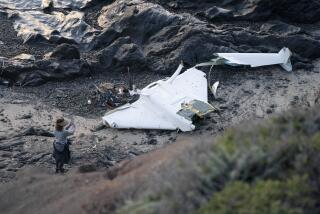Kitty Hawk Replica to Undergo Wind Tests
- Share via
MOFFETT FIELD, Calif. — Sure, NASA has put men on the moon. Now it has a really tough job: Figure out how the Wright brothers got off the ground.
With the 100th anniversary of Kitty Hawk approaching, the pressure is on to build a plane that would be as near as possible to the Wright Flyer, the flimsy biplane that opened the skies to the world.
The National Aeronautics and Space Administration is helping with the project for a Dec. 17, 2003, flight marking the historic event.
The latest full-scale replica of the Flyer is the work of the Los Angeles section of the American Institute of Aeronautics and Astronautics. Volunteers used plans provided by the Smithsonian Institution where the Wright Flyer is on display.
If all goes as planned, the plane will serve as a sort of guinea pig for a later model that will grab all the headlines in 2003.
Starting in June, the public will get a chance to see the plane in a cavernous hangar that once housed the airship Macon.
The next big step for the little plane with the 40-foot wingspan will come in January when it will be subjected to two weeks of tests in the world’s largest wind tunnel.
“I can’t think of anything as exciting as using modern technology to test a replica of the biplane that Orville and Wilbur Wright flew for the first time ever,” said Pete Zell, the test manager at the 80-foot-by-120 foot tunnel.
Virtually every major American military and civilian aircraft produced in the last 50 years has been tested in the wind tunnel at NASA’s Ames Research Center, 35 miles south of San Francisco.
“The Wright brothers used a small wind tunnel to test a model,” Zell said. “If they had this, they would have learned a lot.”
Engineers will study the replica’s stability and handling at speeds up to 30 mph. Results will be used to compile an aerodynamic database of the Flyer, Zell said.
Near-replica might be a more exact term. Already, some changes have been made. The plane was strengthened so it would survive the rigors of the wind tunnel, but in design, size, appearance and aerodynamics it’s the same.
The information provided by the tests will be used to improve the flying qualities and safety of the next Wright Flyer, the one slated to make the anniversary flight.
During the reenactment, the plane will fly at only 30 mph, the top speed of Orville Wright, who traveled only 120 feet during his 12 seconds in the air.
The key to the Wrights’ success was their discovery of how to control the plane by shifting body weight, said Steve Shackelford, an air traffic controller who helped build the Flyer replica.
“What is it that the Wright brothers knew that we still don’t?” wondered Shackelford. He expects the wind-tunnel tests to come up with some answers.
One thing it can’t provide is the luck the brothers had on Dec. 17, 1903. The weather was a “meteorological turning point” in history, Shackelford said.
The Wrights had a 22-knot head wind in near freezing conditions that gave the plane more lift.
“The wrong velocity and they could have turned over,” Shackelford said.
The pilot of the 1903 Flyer was prone and not strapped in, thus free to move to control the plane with his body.
What body movements are needed could come out of the tests. More important is finding out what can be done to make the replica safer for the pilot while remaining honest to the spirit of reenactment.
Flying the plane will be dangerous. Just ask Ken Kellett of Auburndale, Fla., who built and flew a Wright Flyer replica for the 75th anniversary in 1978.
“It can hurt you,” said Kellett, whose plane is on display at Fantasy of Flight near Disney World in Florida.
Kellett said he has crashed several times.
“It crashed once and hit nose first,” said the pilot, who has flown the replica 23 times, mostly for movie work.
He said he was “thrown clear in one crash but suffered a concussion.”
“I hope they learn something from the wind tunnel that will make it safer,” he said. “I wish them luck.”
The designated pilot for the 2003 flight is Fred Culick, a professor of aeronautics at Caltech.
He said his main aim is to understand the 1903 flight better.
Actually flying the plane, Culick said, is “frosting on the cake.”
More to Read
Sign up for Essential California
The most important California stories and recommendations in your inbox every morning.
You may occasionally receive promotional content from the Los Angeles Times.













